Nearly two years ago at the Flash Memory Summit, Liqid announced its Honey Badger SSD, or properly known as the Liqid Element LQD4500 edge card. At the time, the company claimed that this was the world’s fastest NVMe storage. How fast? The claims were 24GB/s and over 4 million IOPS at the time, again, a couple of years back.
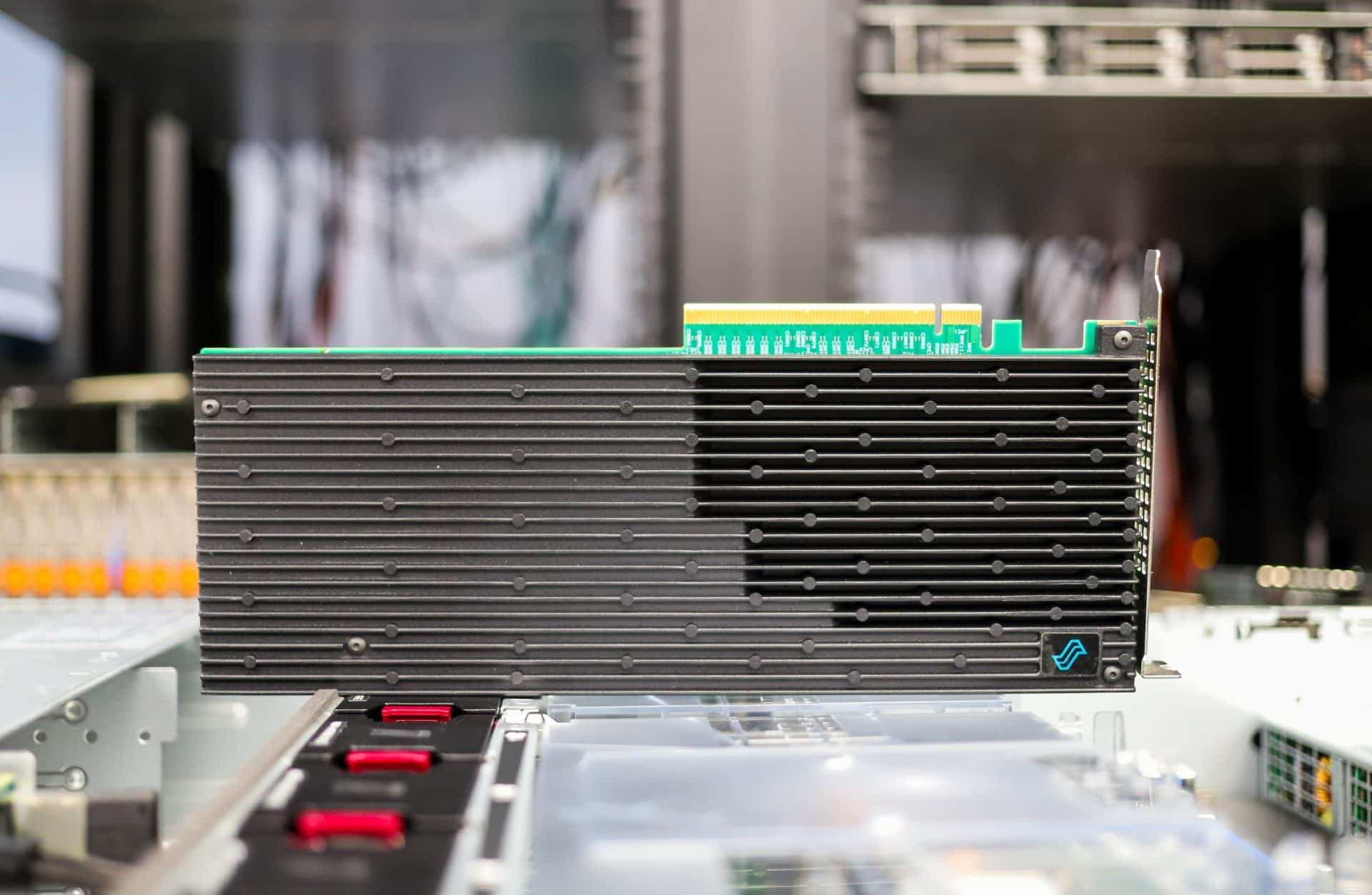
How does the Liqid Element LQD4500 deliver performance?
The quoted numbers are pretty impressive, so how does the SSD get there? First off, it leverages the PCIe Gen4 interface, which at the time of the announcement wasn’t very common. The drive is also composable meaning that it can be configured in different ways, for max redundancy or maximum performance. The drive is quoted as delivering the above performance with as little as 20μs for latency.
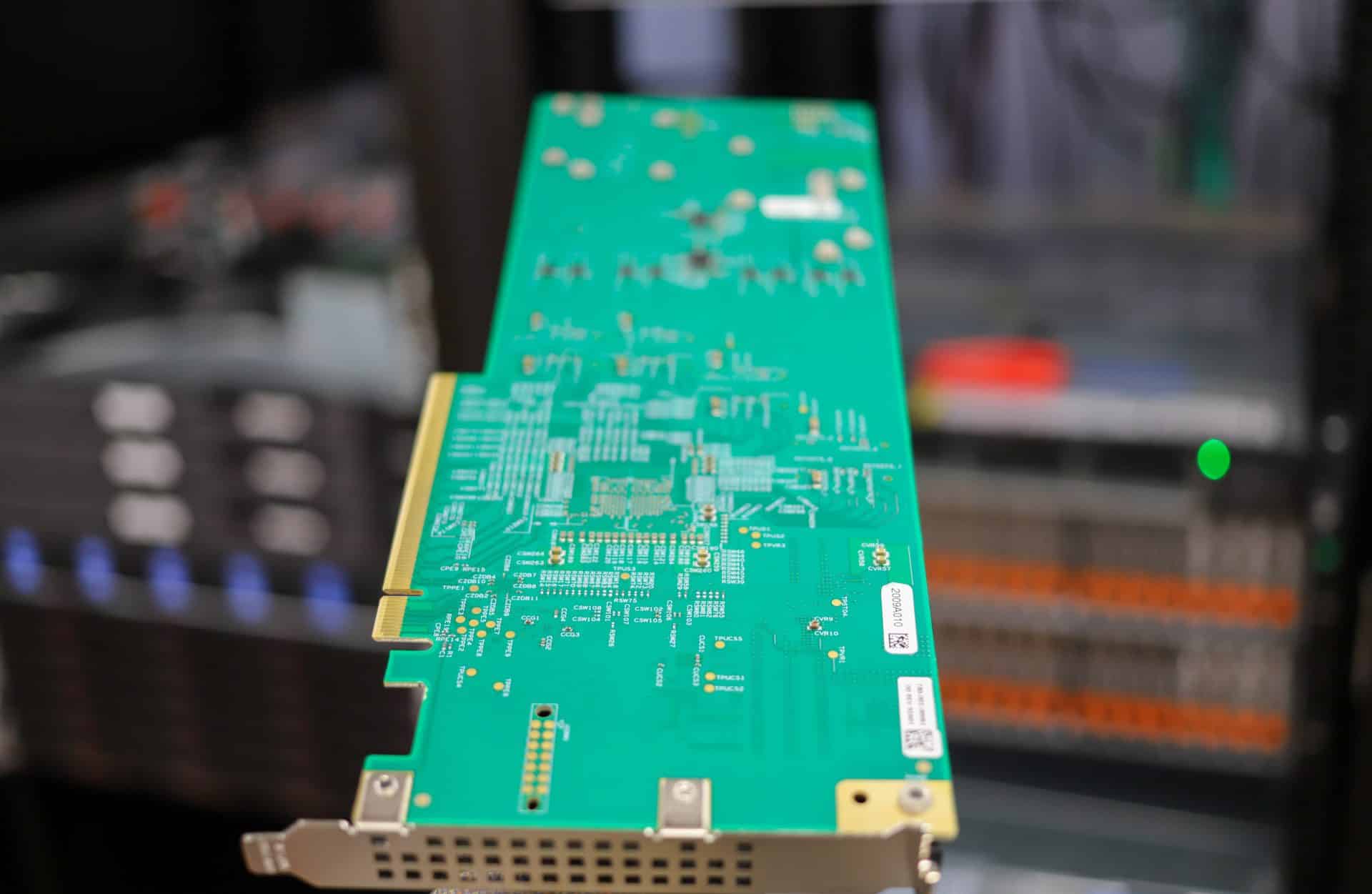
The SSD comes in an FHFL AIC though it is a slim AIC fitting in a single expansion slot. In this form factor, Liqid was able to pack in 32TB of capacity into certain configurations. For endurance, the Liqid Element LQD4500 offers up to 61.53PBW depending on the eight underlying SSDs. Along with general composability, users can throttle thermal output and actively manage power as well.
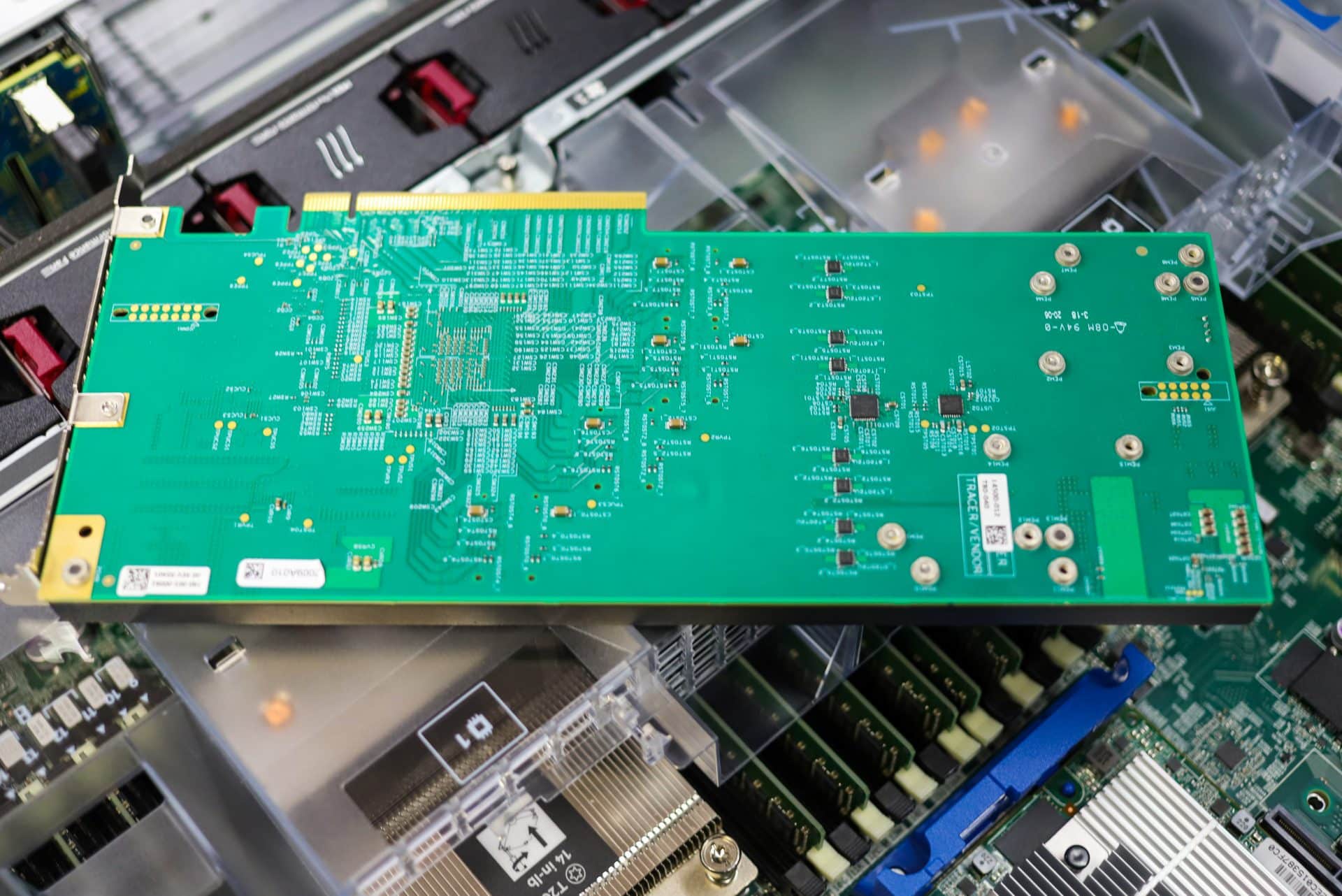
Let’s look at the capacity for a moment. This isn’t a card filled with large NAND packs. Instead, there are up to eight M.2 SSDs on the Honey Badger. For our review, we are using 2TB Toshiba XG5-P SSDs, similar to the Toshiba XG5 we reviewed here. The card can take these 8 Gen3 drives and use the PCIe Gen4 switch onboard to hit higher numbers overall. This is different than others that leverage PCIe port bifurcation to connect multiple individual drives to a single PCIe slot. It should also be noted that performance will vary depending on the underlying SSDs.
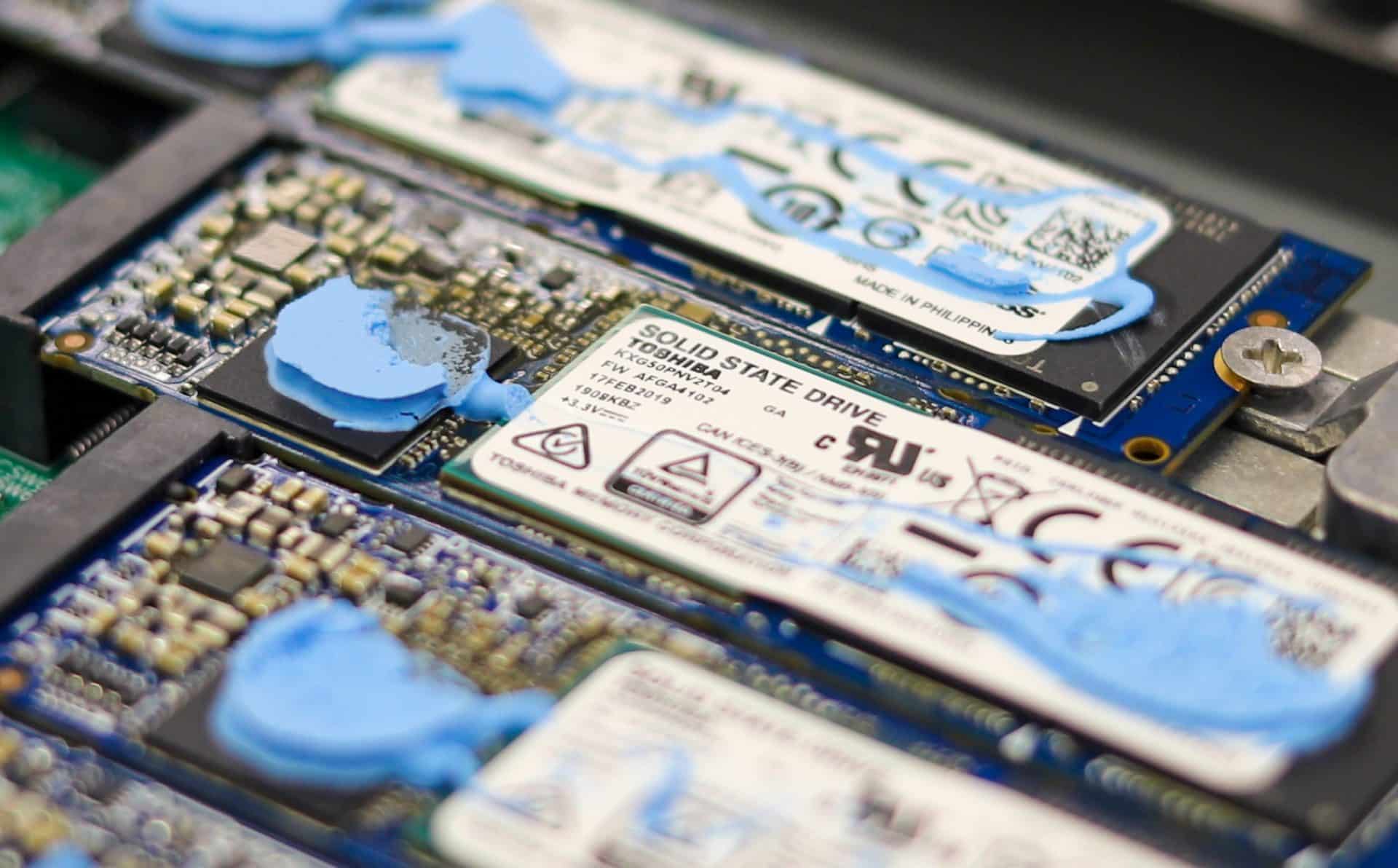
There are two “flavors” here, data center and enterprise. The data center version offers 7.68TB, 15.36TB, and 30.72TB configurations through different capacity Samsung 983 M.2 SSDs. For the enterprise version, the company offers 6.4TB, 12.8TB, and 25.6TB configurations. These various builds go a long way toward how the Honey Badger can hit different speeds as well as its top capacities.
Liqid Element LQD4500 Specifications
| Form Factor | FHFL Card |
| Raw Capacity | Up to 32 TB |
| NAND Type | TLC 3D NAND |
| Protocol | NVMe 1.3 |
| Bus Interface | PCI Express 4.0 x16 |
| Performance | |
| Read Bandwidth (GB/s) | ~24 |
| Write Bandwidth (GB/s) | ~24 |
| Ran. Read IOPS (4k) | ~4,000,000 |
| Ran. Write IOPS (4k) | ~4,000,000 |
| Ran. Write IOPS (4k) (SS) | ~600,000 |
| Read Access Latency | ~80μs |
| Write Access Latency | ~20μs |
| Endurance | Up to 61.53 PBW |
| Security | AES Data Encryption |
| Power |
|
| Temperature |
|
| Air Flow | Min 400 LFM |
| Humidity | 5% to 95% (non-condensing) |
| Operating Environments | Windows, Windows Server 2012, 2012 R2 |
| Weight | 20 oz |
| Warranty | 3 years or maximum endurance used |
Design and Build
The Liqid Element LQD4500 isn’t the normal enterprise SSD. It is an FHFL AIC that slots in but it has an interesting design. The overall card is fairly slim, so it doesn’t take up too much space inside of a server in terms of z-height. The card is very long though (in spec), which makes it difficult to use. Many PCs can handle it just fine, but when it comes to servers, that’s another issue. Only a small percentage of the Gen4 servers in our lab could fit the card.
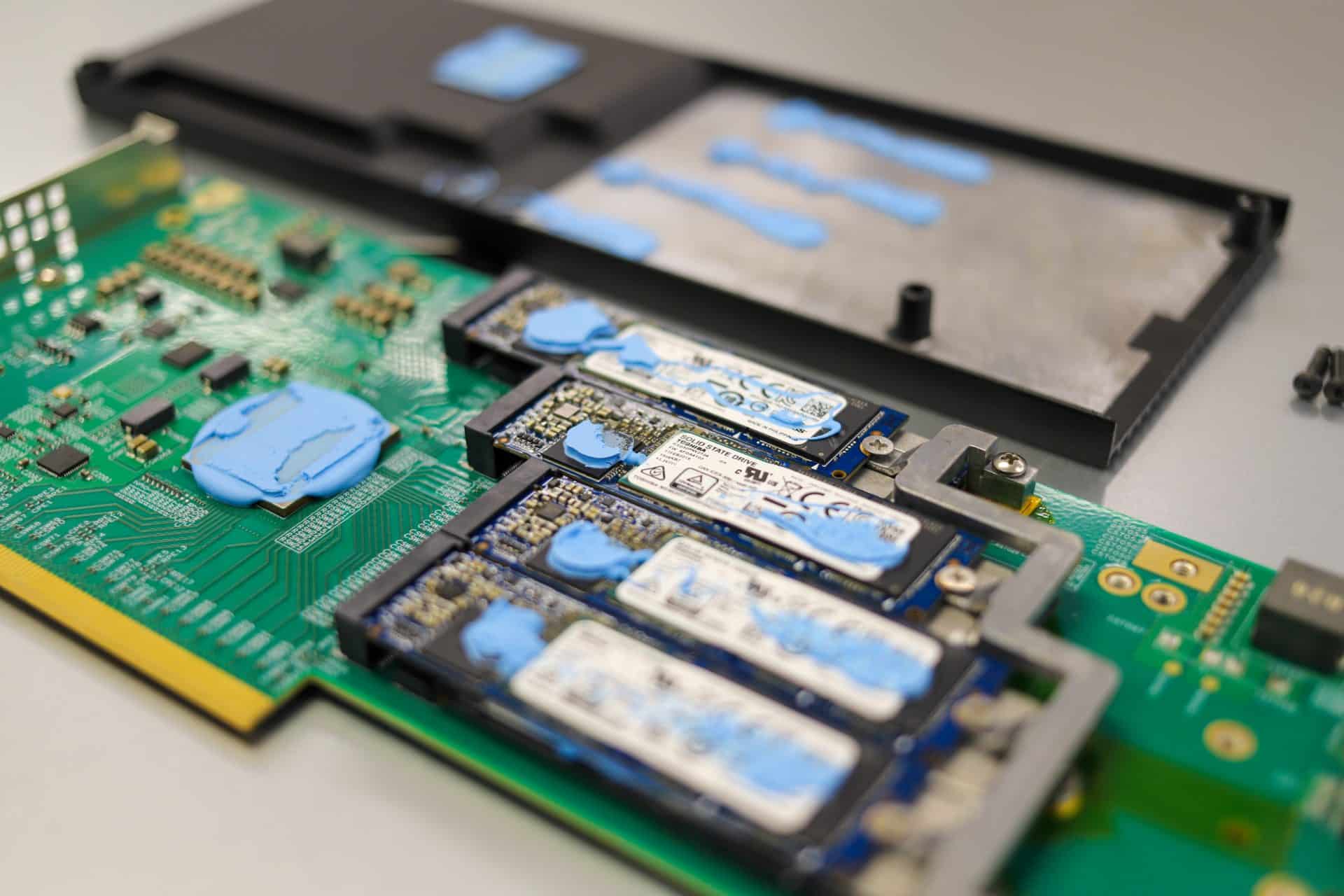
The top of the card is covered in a fairly large heat sink. It can be peeled off though, revealing the double-stacked SSDs inside. Not to worry about the blue goop, that’s thermal transfer past for the SSDs and the PCIe Gen4 switch which is on the board. The design is really quite novel, it’s unusual and cool to see storage set up in such a manner.
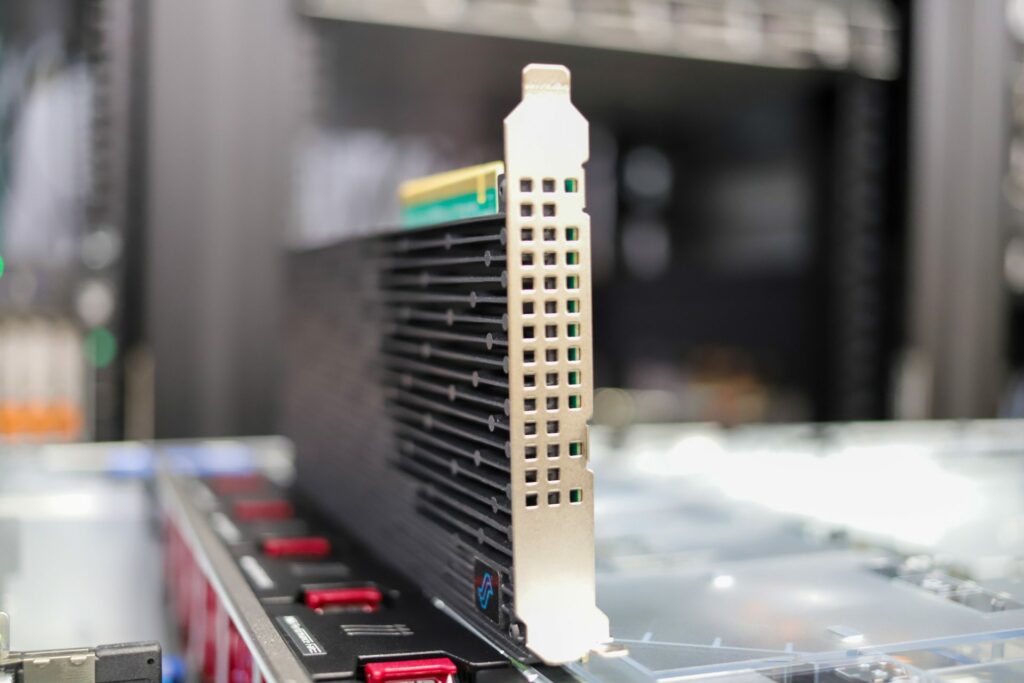
Liqid Element LQD4500 Performance
VDBench Workload Analysis
When it comes to benchmarking storage devices, application testing is best, and synthetic testing comes in second place. While not a perfect representation of actual workloads, synthetic tests do help to baseline storage devices with a repeatability factor that makes it easy to do apples-to-apples comparisons between competing solutions. These workloads offer a range of different testing profiles ranging from “four corners” tests, common database transfer size tests, to trace captures from different VDI environments.
All of these tests leverage the common vdBench workload generator, with a scripting engine to automate and capture results over a large compute testing cluster. This allows us to repeat the same workloads across a wide range of storage devices, including flash arrays and individual storage devices. Our testing process for these benchmarks fills the entire drive surface with data, then partitions a drive section equal to 25% of the drive capacity to simulate how the drive might respond to application workloads. This is different than full entropy tests which use 100% of the drive and takes them into a steady state. As a result, these figures will reflect higher-sustained write speeds.
Profiles:
- 4K Random Read: 100% Read, 128 threads, 0-120% iorate
- 4K Random Write: 100% Write, 64 threads, 0-120% iorate
- 64K Sequential Read: 100% Read, 16 threads, 0-120% iorate
- 64K Sequential Write: 100% Write, 8 threads, 0-120% iorate
- Synthetic Database: SQL and Oracle
- VDI Full Clone and Linked Clone Traces
In our first VDBench Workload Analysis, Random 4K Read, the Liqid Element LQD4500 gave us a peak of 2,185,469 IOPS at a latency of 455µs.
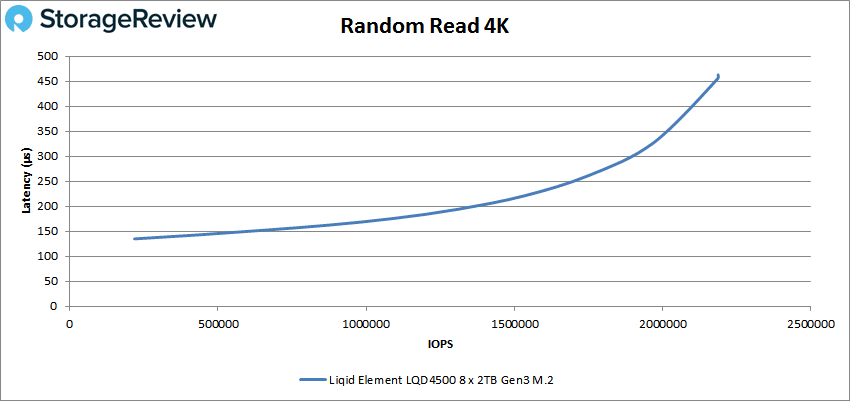
4K write saw the Honey Badger start with latency as low as 25µs, the drive went on to peak at 819,815 IOPS with a latency of 944µs.
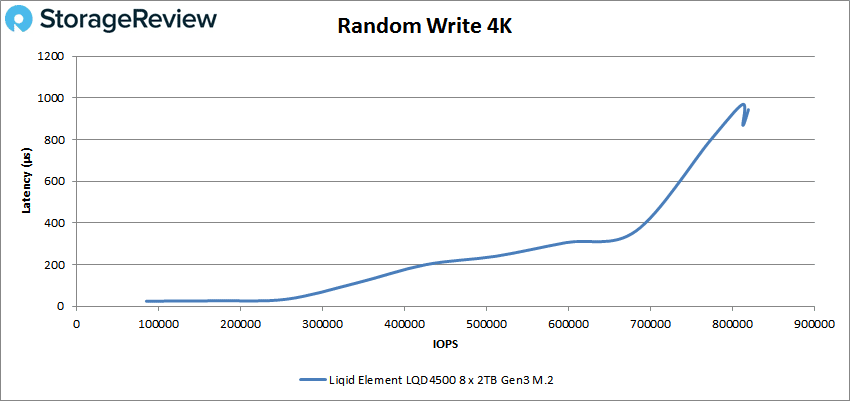
Switching over to our sequential, 64K workloads, in read we saw a peak of about 218K IOPS or 13.6GB/s at a latency of just over 1ms.
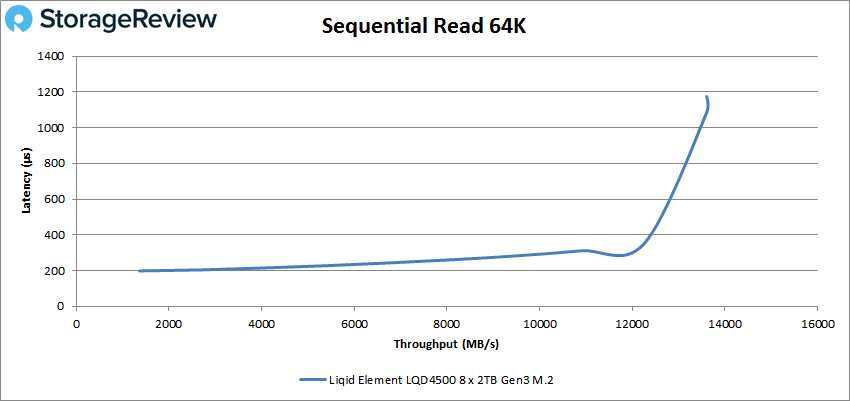
For 64K write we saw a peak of 52,059 IOPS or 3.3GB/s at a latency of 2.4ms.
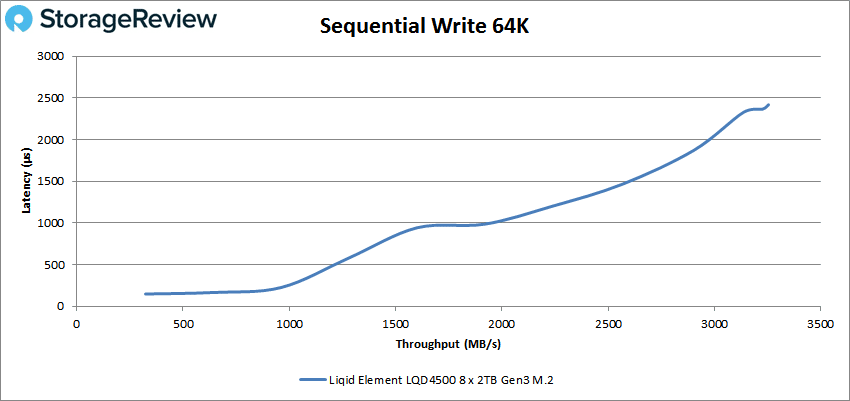
Our next set of tests are our SQL workloads: SQL, SQL 90-10, and SQL 80-20. Starting with SQL the Liqid drive peaked at 989,819 IOPS with a latency of 266µs.
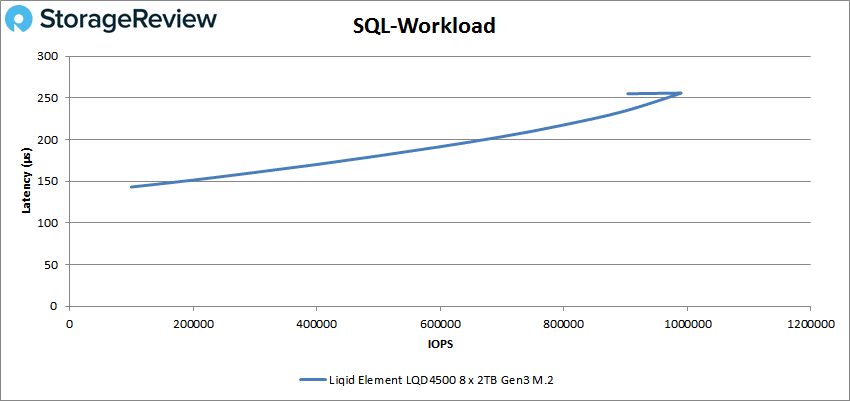
SQL 90-10 saw a peak of 618,010 IOPS at a latency of 347µs.
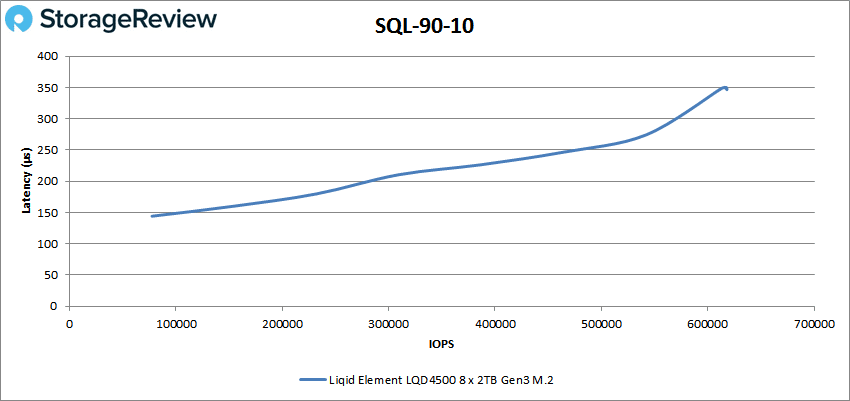
In SQL 80-20 we saw the Liqid Element LQD4500 hit a peak of 572,844 IOPS at a latency of 405µs.
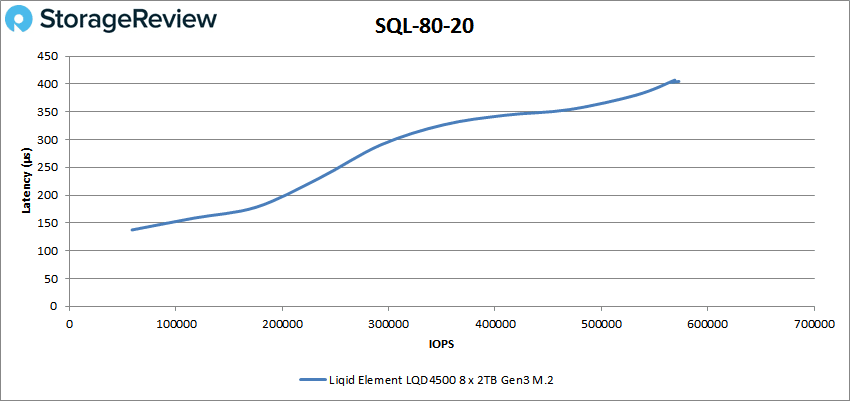
Next up are our Oracle workloads: Oracle, Oracle 90-10, and Oracle 80-20. Starting with Oracle, the drive gave us a peak of 493,325 IOPS at a latency of 476µs.
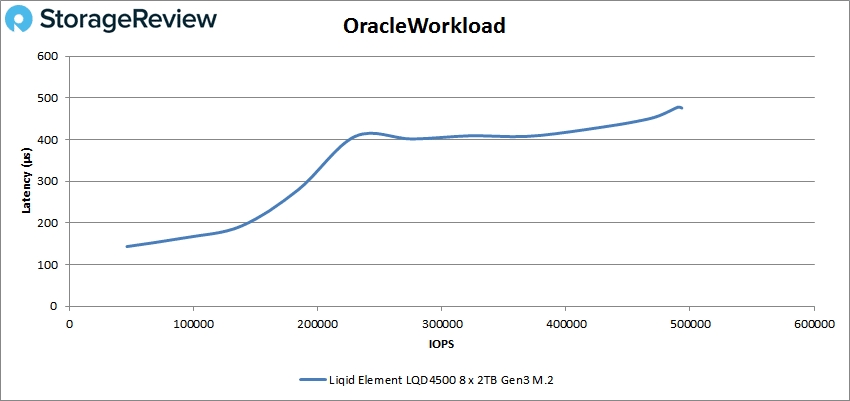
For Oracle 90-10 the Honey Badger had a peak performance of 563,626 IOPS and a latency of 274µs.
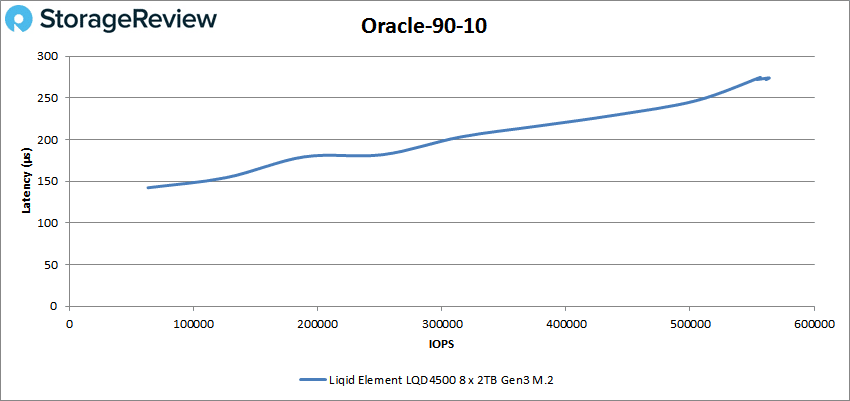
Oracle 80-20 saw a peak of 450,701 IOPS at a latency of 343µs.
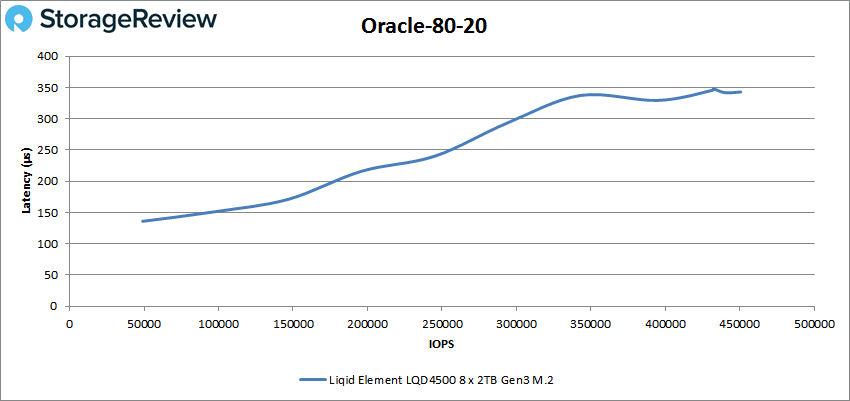
Next, we switched over to our VDI clone test, Full and Linked. For VDI Full Clone (FC) Boot, the Honey Badger saw a peak of 499,859 IOPS at a latency of 442µs before dropping off some.
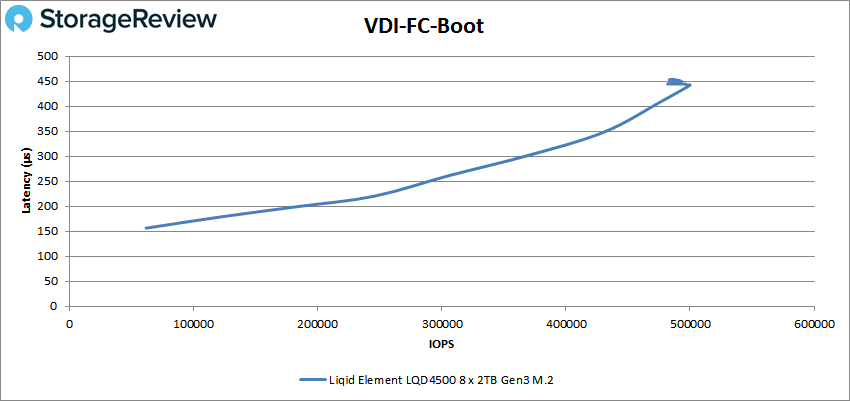
VDI FC Initial Login saw the Liqid hit 149,324 IOPS and latency of 1.4ms.
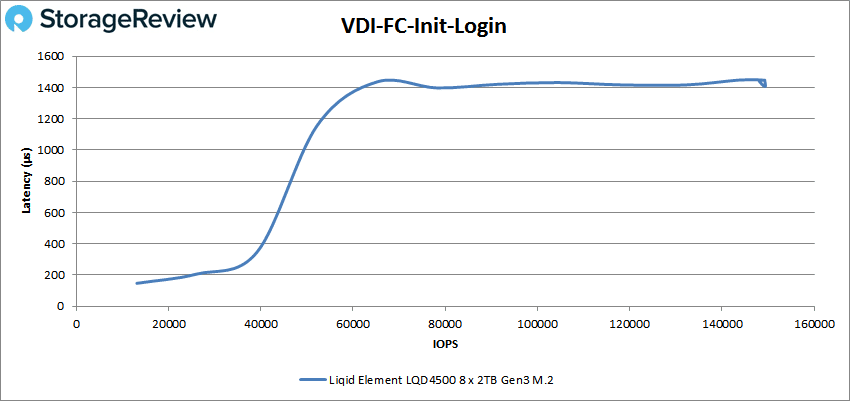
With the VDI FC Monday Login the drive had a peak of 114,793 IOPS and a latency of 895µs, though it was above 1ms earlier.
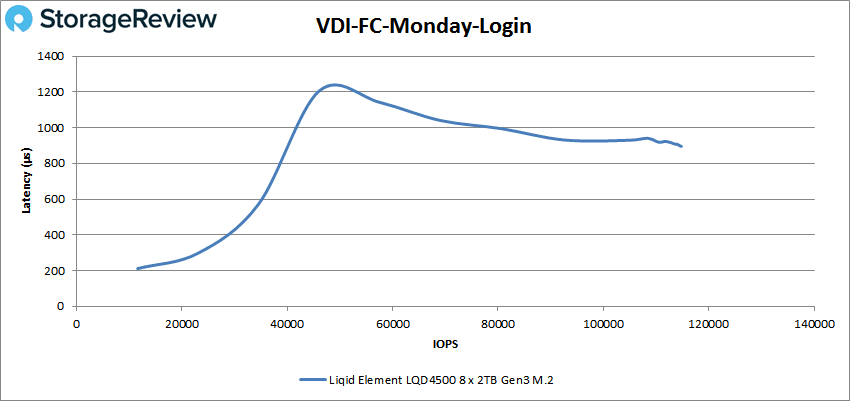
For VDI Linked Clone (LC) Boot, the Liqid Element LQD4500 hit peak performance of 322,332 IOPS and 310µs for latency before dropping off some.
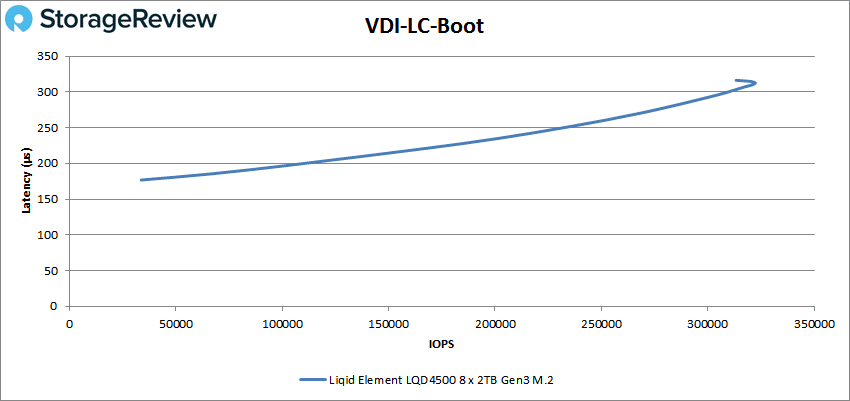
VDI LC Initial login gave us a peak of 63,144 IOPS and a latency of 802µs.
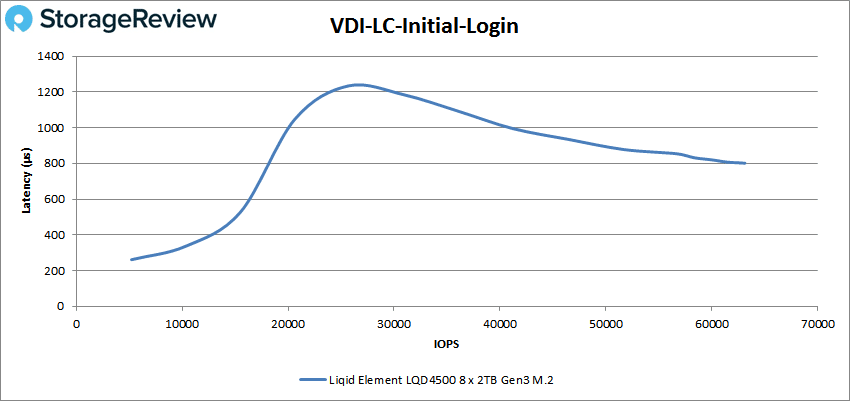
Finally, with VDI Monday Login the drive was able to hit a peak of 93,103 IOPS at a latency of 1.1ms.
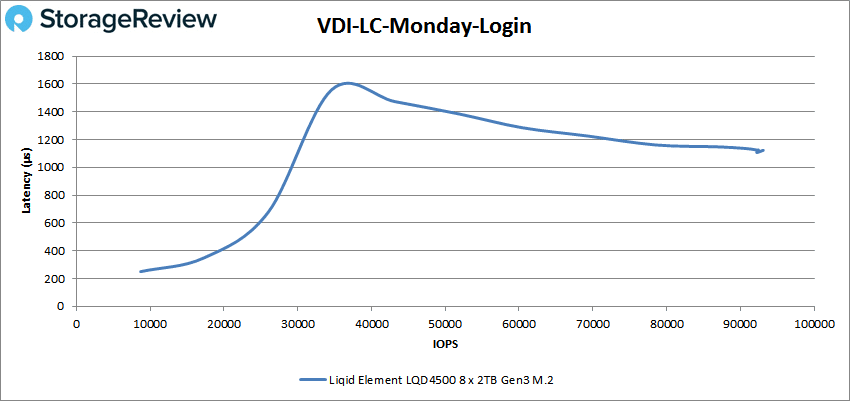
Conclusion
At its release, the Liqid Element LQD4500 PCIe AIC SSD (codenamed Honey Badger) was billed as the fastest SSD in the world. That may have been true at the time, as there were virtually no PCIe Gen4 SSD available, though times have changed. Still, the AIC comes with some very nice quoted speeds of maxes up to 24GB/s and over 4 million IOPS all at less than 20μs for latency. The card works by taking up to eight M.2 SSDs and combines the speed through an onboard PCIe Gen4 switch. While our early version included eight Gen3 SSDs, the platform is agnostic and capable of leveraging different models for even greater performance. The only limiting factor then is the x16 Gen4 slot and a server or PC that can support the full-height, full-length card.
For performance our configuration was not the fastest in the world, but impressive nevertheless. Highlights include over 2 million IOPS in 4K read, 820K IOPS in 4K write, 13.6GB/s in 64K read, and 3.3GB/s in 64K write. In our SQL workloads, we saw peaks of 990K IOPS, 618K IOPS in SQL 90-10, and 573K IOPS in SQL 80-20. For our Oracle workloads, the Honey Badger hit peaks of 493K IOPS, 564K IOPS in Oracle 90-10, and 451K IOPS in Oracle 80-20. Next up were our VDI clone tests Full and Linked. In VDI Full Clone we saw 500K IOPS in boot, 149K IOPS in Initial Login, and 115K IOPS in Monday Login. VDI Linked Clone we saw peaks of 322K IOPS in boot, 63K IOPS in Initial Login, and 93K IOPS in Monday Login.
The Honey Badger is hands down one of the best M.2 edge card designs we’ve seen, focusing on the enterprise market versus the prosumer market, where similar designs have focused. The card is able to take the performance of several M.2 drives and combine them through a PCIe switch, all for higher performance. The design is more robust than others that require port-bifurcation to work, although that comes with a higher price tag.
Overall, the Honey Badger was Liqid’s gateway product. Something that when it was launched, garnered a ton of attention because of the topline speed, Gen4 interface, and onboard PCIe switch. This let Liqid lead with the fun and fast card but backfill the sales motion with their composable infrastructure message, which is far more meaningful for the company. Server design has caught up some, and while you can’t get 24GB/s in a single slot (yet), there are many reasons, like serviceability, performance, and selection, why U.2/3 SSDs may be more compelling. Even so, the Honey Badger is a special design and one that creative pros, hyperscalers, and others may benefit greatly from.
Update 7/13/2021 – Liqid has requested that we take a look at their latest iteration of this product, which they say offers a much better performance profile than the unit they sent us last year. As we noted in this review, the card was definitely hampered by the older drives inside. We look forward to seeing what a more modern Honey Badger can do and will update here with new results when completed.




 Amazon
Amazon